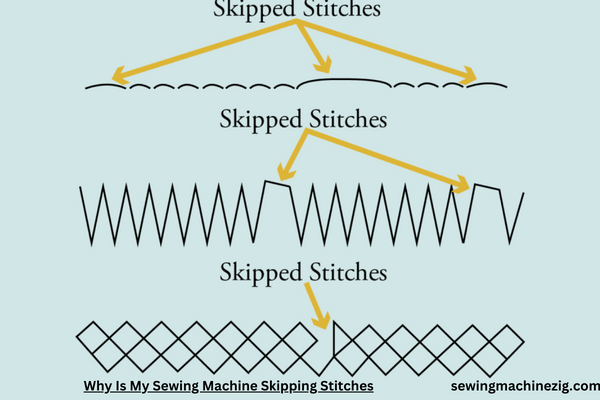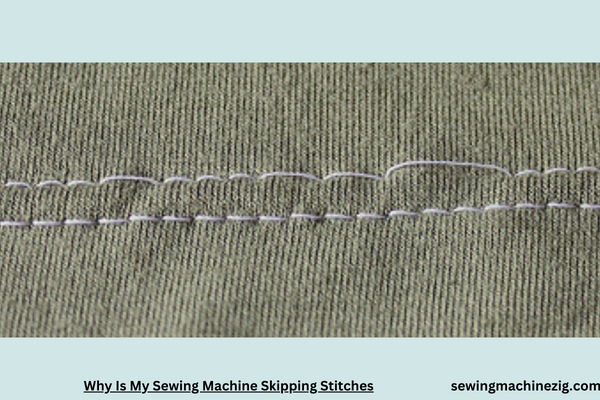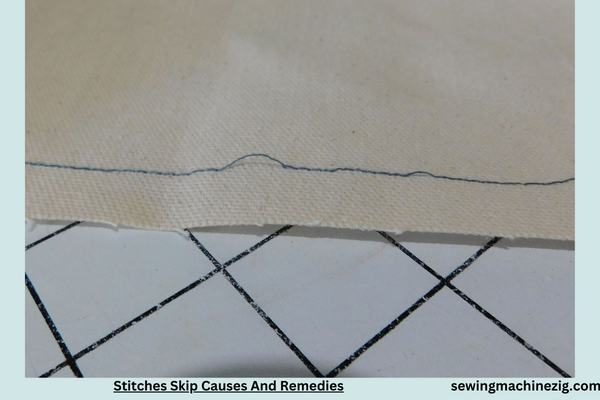
Embarking on a sewing project only to discover skipped stitches can be a frustrating hiccup in the creative process. If you’ve found yourself pondering, “Why Is My Sewing Machine Skipping Stitches?” fear not, as we unravel the common culprits behind this perplexing issue. From needle-related problems to tension troubles, this guide provides insights into troubleshooting and resolving the stitching anomalies.
Uncover the intricacies of your sewing machine’s performance and equip yourself with the knowledge to address skipped stitches, ensuring smoother and uninterrupted stitching for your future crafting endeavors.
Why Is My Sewing Machine Skipping Stitches Detailed Answer

Experiencing the frustration of a sewing machine skipping stitches can disrupt the joy of crafting. In this extensive guide, we will unravel the potential causes behind this common issue and provide a detailed step-by-step process to troubleshoot and resolve the problem, ensuring your sewing projects proceed seamlessly. “Why Is My Sewing Machine Skipping Stitches“
Step 1:
Evaluate Needle Condition A dull or bent needle is a primary culprit for skipped stitches. Begin by inspecting the needle closely. If it shows signs of wear or damage, replace it with a new, appropriate needle for your fabric.
Step 2:
Check Needle Size and Type Ensure you are using the correct needle size and type for your chosen fabric. Using a needle too large or too small for the fabric weight can lead to skipped stitches. Refer to your sewing machine manual for needle recommendations.
Step 3:
Verify Thread Quality Low-quality or old thread can contribute to stitching issues. Choose a high-quality thread suitable for your fabric and project. If the thread has been sitting for an extended period, consider replacing it with a fresh spool.
Step 4:
Thread Tension Adjustment Incorrect thread tension is a common cause of skipped stitches. Check the tension settings on your sewing machine. Ensure that the upper and lower thread tensions are balanced for optimal stitching. Consult your manual for guidance on adjusting tension.
Step 5:
Clean and Oil the Machine A poorly maintained machine can lead to stitching problems. Regularly clean the bobbin area, feed dogs, and other critical components. Additionally, lubricate the machine with sewing machine oil according to the manufacturer’s recommendations.
Step 6:
Examine the Bobbin A improperly wound or inserted bobbin can result in skipped stitches. Ensure the bobbin is correctly wound and inserted into the bobbin case. Check for any tangles or uneven winding that may impede smooth thread flow.
Step 7:
Inspect the Needle Plate A damaged or scratched needle plate can cause fabric snags and skipped stitches. Examine the needle plate for any irregularities. If necessary, replace the needle plate with a new one compatible with your sewing machine model.
Step 8:
Adjust Stitch Length and Width Incorrect stitch length or width settings can lead to stitching irregularities. Check your machine’s settings and adjust the stitch length and width according to your project requirements. Experiment with different settings to find the optimal combination.
Step 9:
Evaluate Fabric and Needle Compatibility Mismatched fabric and needle combinations can result in skipped stitches. Ensure the needle is appropriate for the fabric type and weight you are sewing. Delicate fabrics may require a finer needle, while heavier fabrics need a sturdier one.
Step 10:
Test on Scrap Fabric Before resuming your project, conduct a test on scrap fabric. This allows you to observe any remaining stitching issues and make additional adjustments as needed. Pay close attention to the stitch quality and make fine-tune adjustments accordingly.
Understanding why your sewing machine is skipping stitches empowers you to troubleshoot and resolve the issue efficiently. By following these comprehensive steps, “Why Is My Sewing Machine Skipping Stitches” you can identify the root causes, implement corrective measures, and enjoy a seamless stitching experience.
Regular maintenance, proper needle and thread selection, and attention to detail will ensure that your sewing machine produces flawless stitches, allowing you to pursue your creative endeavors with confidence.
Stitches Skip Causes And Remedies

Encountering the vexing issue of skipped stitches in your sewing projects can be disheartening. In this comprehensive guide, we will delve into the intricacies of stitches skip causes and provide a step-by-step process for identifying, troubleshooting, and implementing effective remedies, ensuring your sewing endeavors are smooth and frustration-free.
Step 1:
Assess Needle Condition The first culprit to consider when stitches skip is the needle. Examine the needle closely for any signs of wear, bending, or damage. If detected, promptly replace the needle with a new, compatible one suitable for your fabric.
Step 2:
Verify Needle Size and Type Ensure you are using the correct needle size and type for your specific fabric. Using an inappropriate needle size or type can lead to stitches skipping. Refer to your sewing machine manual for recommendations on needle sizes based on fabric weight.
Step 3:
Thread Quality Check Low-quality or old thread can significantly contribute to stitching irregularities. Opt for a high-quality thread appropriate for your fabric and project. If the thread has been sitting for an extended period, consider replacing it with a fresh spool.
Step 4:
Tackle Thread Tension Issues Incorrect thread tension is a prevalent cause of stitches skipping. Check both upper and lower thread tensions on your sewing machine. Ensure they are balanced for optimal stitching quality. Refer to your manual for guidance on adjusting thread tension settings.
Step 5:
Regular Machine Maintenance A well-maintained sewing machine is less prone to stitching problems. Regularly clean the bobbin area, feed dogs, and other critical components. Additionally, lubricate the machine with sewing machine oil according to the manufacturer’s recommendations to facilitate smooth operation.
Step 6:
Evaluate the Bobbin An improperly wound or inserted bobbin can lead to stitches skipping. Verify that the bobbin is correctly wound and inserted into the bobbin case. Look for any tangles or uneven winding that may impede proper thread flow.
Step 7:
Inspect the Needle Plate A damaged or scratched needle plate can cause fabric snags and contribute to stitches skipping. Examine the needle plate for any irregularities. If necessary, replace the needle plate with a new one compatible with your sewing machine model.
Step 8:
Adjust Stitch Length and Width Improper stitch length or width settings can result in stitching irregularities, including skipped stitches. Check your machine’s settings and adjust the stitch length and width according to your project requirements. Experiment with different settings to find the optimal combination.
Step 9:
Evaluate Fabric and Needle Compatibility Mismatched fabric and needle combinations can lead to stitches skipping. Ensure the needle is appropriate for the fabric type and weight you are sewing. Delicate fabrics may require a finer needle, while heavier fabrics need a sturdier one.
Step 10:
Test on Scrap Fabric Before resuming your project, conduct a test on scrap fabric. This allows you to observe any remaining stitching issues and make additional adjustments as needed. Pay close attention to the stitch quality and make fine-tune adjustments accordingly.
Unraveling the mysteries of stitches skip causes and implementing effective remedies requires a systematic approach.
By following these comprehensive steps, you can identify, troubleshoot, and address the root causes of skipped stitches in your sewing projects. Regular maintenance, proper needle and thread selection, and meticulous attention to detail will pave the way for flawless stitches, allowing you to pursue your creative endeavors with confidence.
Conclusion
In conclusion, “Why Is My Sewing Machine Skipping Stitches” unraveling the mystery of why a sewing machine skips stitches is key to elevating your stitching experience. By delving into potential causes like needle choice, tension adjustments, and proper machine maintenance, you empower yourself to troubleshoot and enhance stitch consistency.
Embrace the role of detective in your sewing studio, and let each skipped stitch become an opportunity for learning and refinement. With a keen eye and the right adjustments, you’ll transform challenges into triumphs, ensuring your sewing machine stitches flawlessly through every creative endeavor.
FAQs: Why Is My Sewing Machine Skipping Stitches
Q1: Why is my sewing machine skipping stitches during stitching?
A1: Skipping stitches can result from various issues, such as a dull or bent needle, improper threading, tension problems, or a misaligned needle and bobbin.
Q2: How can I determine if a dull needle is causing my sewing machine to skip stitches?
A2: Examine the needle for signs of wear or damage. If it’s dull or bent, replace it with a new, suitable needle for your fabric and sewing project.
Q3: Is incorrect threading a common cause of skipped stitches?
A3: Yes, improper threading, including skipping a thread guide or not threading the needle correctly, can lead to skipped stitches. Re-thread the machine carefully following the manual. “Why Is My Sewing Machine Skipping Stitches“
Q4: Can tension issues cause my sewing machine to skip stitches?
A4: Yes, incorrect tension, both upper and lower, can cause skipped stitches. Adjust the tension settings according to your machine’s manual and the type of fabric you’re using. “Why Is My Sewing Machine Skipping Stitches“
Q5: How can I tell if my sewing machine’s tension is causing skipped stitches?
A5: Check the top and bottom stitches on a piece of scrap fabric. If the tension is incorrect, you may notice loose or tight stitches, and adjusting it can resolve the skipping issue. “Why Is My Sewing Machine Skipping Stitches“
Q6: Can using the wrong thread size cause my sewing machine to skip stitches?
A6: Yes, using the wrong thread size for your needle can lead to skipped stitches. Ensure the thread size matches the needle’s recommended range for your sewing project. “Why Is My Sewing Machine Skipping Stitches“



